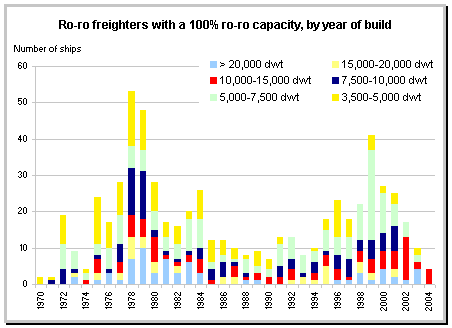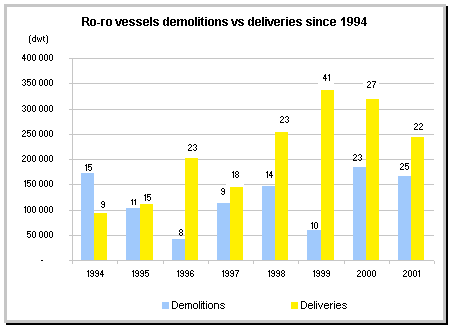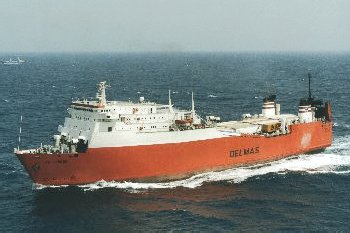
The Ro-Ro market in 2001
|
|
The noose
tightens'
|
|
|
| |
|
The concept of a ro-ro ship is a commitment to
a somewhat unconventional flexibility in the shipping world, as much by
the autonomy it offers in ports with difficult access, as by the diversity
of cargoes that can be handled in ports non or badly equipped with
shore-cranes. While simple and dependable, it seems important to remember
that the ro-ro is also irreplaceable on certain routes. Clearly the
development of port infrastructures for containerships, handling methods
or storage capacities have a direct effect on ro-ro traffic, but there is
still a lot to be done before a massive substitution of one system over
the other can be envisaged.
In terms of comparable units, the capital costs for transporting a
40-foot container by containership are a lot less than the same movement
of a trailer on a ro-ro vessel. The transport cost argument of course
weighs heavily for shippers in their logistical choices and economic pros
and cons, but it is not the only item to be taken into consideration.
Others factors count such as handling speed and above all the continuity
in the transport chain by land in the shortest time.
If all these constraints prevail on a short or medium haul routes, then
the ro-ro takes precedence over the container. Nonetheless it is a case of
"David and Goliath". As we have frequently pointed out, although
the container has got the lion's share of certain long-haul ro-ro
routes, both means of transport can and should exist together in various
parts of the world. We however do not imagine that the ro-ro fleet will
double in the next ten years, as we have seen that has happened in the
containership sector.
On the other hand, we have witnessed a rejuvenation of the fleet, which
while not producing a sizeable increase in capacity, has had the merit of
allowing operators a better quality of service. The analysis of the ro-ro
fleet remains a complicated affair given the diversity of ship types,
since the evolution of the ro-pax concept lends itself in practice to
producing ships which have more affinity to ferries than pure ro-ros. Few
new orders have been recorded in 2001, and deliveries have also been
considerably reduced in 2001 compared to the past three years. Although
the freight market has the same profile as last year's in terms of
volume, time charter rates have been globally reduced.
|

|

|
| The
ro-ro market and geo-politics |
|
|
|
The subject would deserve an analysis on its
own as there has been such an intense activity throughout the year on
movements of military material, either for interventionist reasons or
simply for training purposes. The dramatic events of September 11th in the
U.S. and the intervention of the international community in Afghanistan
did not however produce the same repercussions as the Gulf War did ten
years ago.
The different military organisations have become much better structured
and did not panic when it came to transporting troops and material this
time. The American Military Sealift Command drew from its experiences in
the past and only resorted to the spot market occasionally to cover its
needs, without causing any particular waves or price hikes. The U.S. and
the U.K. are definitely the two countries with the best-integrated fleets
and best-fitted to meet their transport needs. There are in practice the
only two countries with an operating service mechanism capable of making
arbitrages between ships on long-term charter, owned vessels and spot
charters.
Of course other European countries have shown themselves to be
interventionists as well, but have not yet taken the necessary steps to be
able to enforce this policy in the long-term. This waiting attitude
adopted by military organisations has some perverse effects on the market.
First of all, a number of very old ships, which have been financially
written-off for a long time, win a lot of these tenders without their
owners being able to find steady employment for them over the year as a
whole. It gives the military the benefit of covering their transport needs
at competitive costs, but with little anticipation for the medium or
long-term. This attitude may become difficult to manage sooner or later.
In practice there are still a lot of ships in service built in the
middle and at the end of the 70's. Although it is possible to charter
and buy these second-hand ships cheap today, the effect of a fairly
massive scrapping would soon be felt in terms of transport supply and also
immediately in prices. Owners of more modern ships, built in the 80's
and early 90's could then hope for a second breath, as they are amongst
those suffering most from the current very low freight rates and lack of
employment. The running costs of meeting such low utilisation and the poor
returns of period business have pushed some owners into laying-up, often
unable to compete with older ships in the spot "military"
market.
As frequently the case, it is impossible to generalise about this
market and the specific character of each ship makes them almost
individual special cases - with one or two additional knots, a car deck, a
straight or quarter ramp, etc. - matters which differentiate one from
the other and can make or break a deal. All these are items which
potential buyers of second-hand vessels will have to take into
consideration in their choice.
| Profession:
tramp owner' |
|
|
|
The predominant tendency over the last few
years, which has led the majority of large operators to own their ships
rather than charter-in has not reversed, on the contrary. The initiatives
of owners, which have ordered newbuildings to "play the market"
have proven to be highly dangerous.
Armada has reduced their assets over the last years to simply ensure a
continuous employment of their ships, and it does not seem that they are
in an expansionist mood.
Stena, who several years ago threw themselves into a phase of renewing
their fleet in an inspired manner, have the big advantage of working with
a "safety-net", capable of operating an arbitrage on their own
lines if ordered vessels should find themselves without tramping
employment. Nonetheless Stena still have to absorb three more ships of
3,000 lane metres in the year 2002.
The owner Visentini remains today an isolated case of really gambling
on the future, building his ships in his own yard and with his own designs
but with undeniable success. This unique example is worth citing for its
visionary aspect, and in parallel with a policy of renewing the smallest
and oldest ships, finding success with sales to Stena as well as the
Turkish Ege Roro, for example.
Other owners like Ernst Russ are paying the cost of the very reduced
activity on the spot market. Already owners of four ships of 1,650 lane
metres backed with period charters, they have received at the beginning of
the year a unit of 2,500 lane metres 22.5 knots, which saw its initial
employment in the Atlantic prematurely terminated in the autumn, leaving
this splendid ship on the shelf in a capricious market.
It will be interesting to see how the sector of the market of fast
2,500-3,000 lane metre ships will evolve in the course of 2002. There is a
fragile balance and the market got tossed about during the second half of
the year due to the introduction of three ships from Ege Roro (2,500 lane
metres). One of them finally found a home with Cotunav. Certain niche
services, which operate with ships of 1,800-2,000 lane metres, could
benefit in 2002 from a possible swap of the bigger sizes of 2,400-3,000
lane metres to allow them to increase their transport capacity at
reasonable costs. Maybe we will see a new class of routes coming into
service and finally shedding in compensation to congested roads. Will the
recent accidents that have hit the trans-Alpine road tunnels lead to new
policies favouring short-sea shipping? We very much doubt it, as history
tends to have a shorter and shorter memory, and we would rather bet on the
well-conceived private initiatives, which should finish being crowned with
success sooner or later.
Having found shelter in different business management structures or
having been sold, a good number of ships built for Russian operators
continue to liven up the market with varying fortune, but with a
preponderance for the largest ships to find period employment on long-haul
routes. Egon Oldendorff operating through a Norwegian commercial
management structure (Atlantica Shipping) already got his way into the
closed circle of tramp owners and seems set to enlarge his presence in
this market, on condition to define and target precisely the type of ship
to focus on, which while remaining risky could prove profitable.
 |
CR Tanger
9,332 dwt, 1,900 lane metres, blt 1978, sold by Delmas (France) to Pasifae Shipping Company (Greece) |
|
| Tomorrow'
|
|
|
Given the age profile of the fleet, and the
ever-approaching deadline of demolition of the oldest ships, we believe
that this is a propitious time to invest in good quality ships of not more
than 15 years at a reasonable price. Assuming that the life span of these
is realistically about 25 years, it is possible that this choice over the
medium term should be positive.
On long-haul routes, the charter market has been particularly quiet.
The decline in the chartering activity is in this instance also linked to
the number of new ships, which have gradually replaced tramp ships,
despite the level of new deliveries in 2001 being below that of the
preceding two years. Grimaldi has remained the most active player in the
pure ro-ro sector (as opposed to the ships of PCC and PCTC). Elsewhere,
Delmas, who is in partnership with Grimaldi on the Mediterranean / West
African Coast trade, has undertaken an external growth transaction at the
end of the year, taking control of their common partner Setramar. Earlier
in the year we had the case of Grimaldi taking control of Atlantic
Container Line, a good example if needed of the interaction between ro-ros
and containers. We can also mention that at the end of the year DFDS,
emblematic actor in the ro-ro market took majority control of Lys line, a
Norwegian operator of containerships.
Facing a difficult horizon for numerous owners in the container
transport market (at least until end 2002), it is not impossible that we
will see several "forced mergers" between niche market operators
in this sector with the biggest ro-ro operators.
Finally and unless there is an important volume of new orders in the
next two years, the ratio of deliveries to demolitions should naturally
get inverted, which could signal the beginning of a new tendency in the
market.
To be continued'
Shipping and Shipbuilding Markets in 2001
I N D E X
|